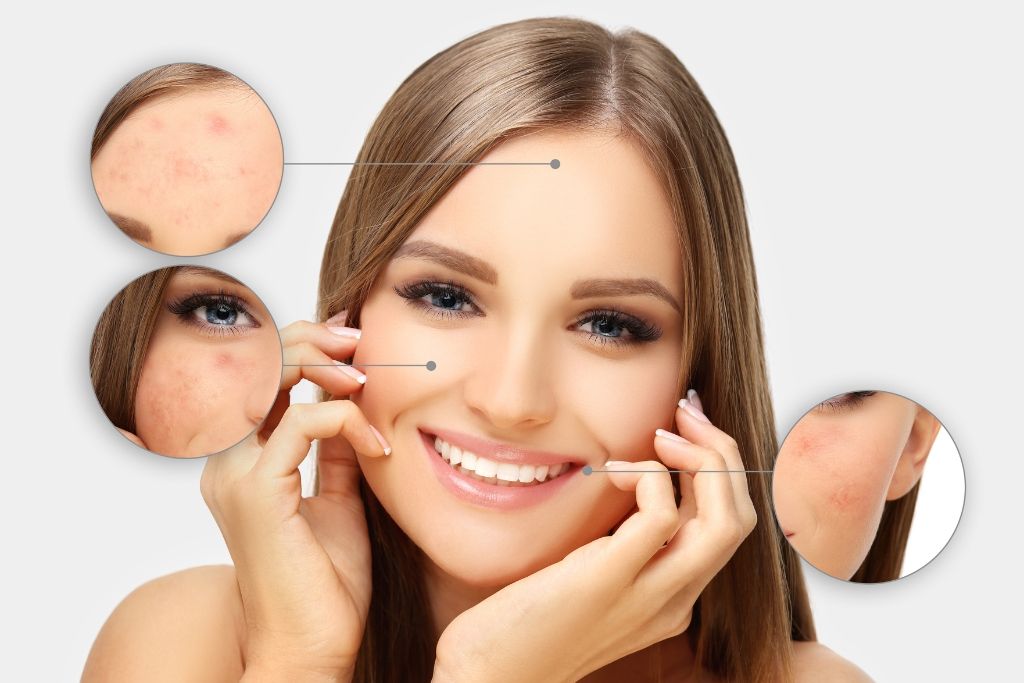Acne scars can be a frustrating daily reminder of a difficult time in your life. While the scars may not be physically harmful, they can greatly affect your self-confidence.
Makeup can be a great help in camouflaging and covering acne scars.
However, applying makeup to acne-prone skin can be tricky.
Here, we’ve compiled 10 expert makeup tips to help you achieve flawless coverage and restore your confidence.
1)) Prepping The Skin
Before applying makeup to acne-prone skin, it’s important to prep the skin.
Apply a lightweight moisturizer to hydrate the skin and allow the makeup to go smoothly.
Next, apply a silicone-based primer to fill in any indents caused by acne scars.
This will give the skin a smoother finish and help the makeup adhere better.
Essential Skin Prepping Tips:
- Exfoliate Gently: Use a gentle exfoliator before applying moisturizer. Exfoliating helps to remove dead skin cells and allows your skincare products to penetrate more deeply, giving you a smoother canvas for makeup application.
- Choose Non-Comedogenic Products: Make sure your moisturizer and primer are non-comedogenic, meaning they don't clog pores. Products that don't block pores reduce the chance of further breakouts.
- Allow Moisturizer to Absorb: After applying your moisturizer, wait for about five minutes to let it completely soak into your skin before applying your primer. This helps to ensure a smooth and even makeup application.
Prepping the skin is a crucial step when applying makeup to acne-prone skin.
A proper routine involving gentle exfoliation, using the right products, and allowing for the absorption of moisturizer can make a significant difference in the application and look of your makeup.
Patience and consistency in your skincare routine can help create the perfect base for your makeup, reducing the visibility of acne scars and boosting your confidence.
2)) Avoid Heavy, Thick Foundations
While it may be tempting to apply a heavy, full-coverage foundation to cover acne scars, this can actually make them look worse.
Heavy foundations can settle into indents and make scars appear deeper. Instead, opt for a lightweight, buildable foundation that won’t clog pores.
Tips for Choosing the Right Foundation:
- Go for Lightweight and Buildable: Choose a foundation that's lightweight and buildable in coverage. This way, you can add extra coverage where needed without making your entire face feel cakey or heavy.
- Opt for Non-Comedogenic Formulations: Just like your skincare products, ensure your foundation is non-comedogenic. This will help to minimize any potential skin reactions and reduce the likelihood of further breakouts.
- Test Before Buying: Always test the foundation on your skin before purchasing. Make sure it blends well, matches your skin tone, and does not emphasize the texture of the scars.
Avoiding heavy, thick foundations is fundamental when dealing with acne-prone skin.
Adopting lightweight, buildable foundations along with non-comedogenic products can significantly improve your makeup application, ensuring it looks natural without worsening the appearance of acne scars.
The right match and blend are just as important, and testing before purchasing can save you from potential skin issues.
Successful makeup application is all about enhancing your natural features, not masking them, so choose products that work for you and not against you.
3)) Invest In A Good Concealer
Concealer can be your best friend when trying to cover acne scars. Look for a creamy, highly pigmented concealer that will provide maximum coverage.
Apply the concealer with a small brush and blend out the edges with a blending sponge for a natural finish.
Essential Tips for Choosing and Applying Concealer:
- Prioritize Coverage and Consistency: Opt for a concealer that offers high coverage but maintains a creamy consistency. This will ensure that it effectively camouflages acne scars and blends seamlessly with your skin.
- Consider Color-Correcting Concealers: If your acne scars have a noticeable color (red or dark), consider using a color-correcting concealer. Green neutralizes red, and peach or orange neutralizes dark spots, providing a base for your regular concealer and foundation to deliver a flawless finish.
- Use the Right Tools: For precise application, use a small, pointed concealer brush to apply the product specifically to the scar. Blend out the edges with a beauty sponge for a natural, seamless appearance.
Investing in a good concealer is a game-changer for those looking to cover acne scars.
By choosing a product that combines high coverage with a creamy consistency, you can effectively conceal and blend scars into your skin tone.
Color-correcting options offer further opportunities for coverage, neutralizing any discoloration for a seamless finish.
The right application tools can also enhance the final look, ensuring precision and an overall natural appearance.
A good concealer not only hides imperfections but also works to boost your confidence and radiate your natural beauty.
4)) Color Correct
Sometimes, acne scars can have a blue or purple tint. To counteract these colors, use a color corrector.
A peach or orange color corrector can be used to neutralize blue or purple-toned scars.
Apply the color corrector before foundation and concealer for the most natural-looking finish.
Tips for Effective Color Correction:
- Identify the Undertone of Your Scars: For effective color correction, first identify the undertones in your scars. Blue or purple scars can be neutralized by peach or orange color correctors, while green correctors work best for redness.
- Application Technique Matters: Apply your color corrector sparingly and precisely on the scar, not all over the face. Blend it out properly to ensure there are no harsh edges before applying foundation or concealer.
- Layer Correctly: Always apply your color corrector before your foundation and concealer to achieve the most natural-looking finish. Set your color corrector with a translucent powder before layering other products to avoid mixing and muddying colors.
Color correction is a useful technique to combat the discoloration often associated with acne scars.
By identifying the undertones in your scars and using a complementary color corrector, you can effectively neutralize these tones for a balanced skin appearance.
The key to successful color correction lies in proper application and layering.
Apply the corrector sparingly, precisely where it's needed, and always remember to blend well.
Follow this with a setting powder before applying your foundation or concealer.
Mastering the art of color correction can be a significant step towards achieving a flawless, natural-looking complexion.
5)) Don’t Forget About Your Neck
When applying makeup to cover acne scars, it’s important to blend well and not forget about your neck.
Make sure to extend foundation, concealer, and powder down to your neck for a seamless look.
Tips for Incorporating Your Neck in Your Makeup Routine:
- Extend Your Foundation: Always extend your foundation down to your neck. This creates a uniform look and prevents the dreaded 'mask' effect where your face and neck are visibly different shades.
- Blend, Blend, Blend: Blending is key when it comes to a natural-looking finish. Blend your makeup well into your neck to ensure there are no obvious lines or differences in texture.
- Don't Neglect Skin Care: Your neck is just as susceptible to acne and scarring as your face. Make sure to include your neck in your skincare routine. Also, while applying sunscreen, don't forget your neck to prevent skin damage.
Incorporating your neck into your makeup routine is crucial for achieving a natural, cohesive look.
By extending your foundation to your neck and blending thoroughly, you can ensure there are no distinct lines or color differences between your face and neck.
Equally important is the inclusion of your neck in your skincare regimen, reinforcing the importance of a holistic approach to beauty.
Your makeup should enhance your overall appearance, not create a disconnect, and your neck plays a significant part in this ensemble.
6)) Use Matte Products
When covering acne scars, avoiding products with shimmer or glitter is best. Stick to matte products, including foundation, concealer, and powder.
Shimmery products can draw attention to acne scars.
Tips for Effectively Using Matte Products:
- Choose Matte Face Products: Opt for matte foundation, concealer, and powder as these do not highlight textures on the skin like glittery or shimmery products do. Matte products help in achieving a smooth and natural look.
- Test Products First: Always test products before purchasing. Check if the matte product blends well and doesn't leave your skin looking too dry or cakey.
- Proper Preparation: Always prepare your skin well before applying matte makeup. Properly moisturizing your skin can prevent the makeup from looking flat or overly dry.
Matte products are an excellent choice for covering acne scars as they do not emphasize skin texture like their shimmery counterparts.
The trick to successfully using matte makeup lies in choosing the right products, doing a patch test for compatibility, and prepping your skin adequately before application.
With the right matte products and techniques, you can minimize the visibility of acne scars, achieving a smoother, more natural complexion.
The goal is not to mask, but to subtly blur imperfections, enhancing your natural beauty.
7)) Set With Powder
For long-lasting wear, set your makeup with a translucent powder. Focus on the areas where your skin tends to get oily throughout the day to prevent makeup from sliding around.
Tips for Setting Your Makeup with Powder:
- Choose the Right Powder: Opt for a translucent setting powder that won't interfere with the color of your foundation or concealer. This helps to lock in your makeup and provides a smooth finish.
- Focus on Oily Areas: Pay special attention to areas that tend to become oily throughout the day such as the T-zone. Setting these areas with a bit of extra powder can prevent your makeup from sliding.
- Use the Right Tools: A fluffy, large powder brush is ideal for applying setting powder. It allows for even distribution and prevents the makeup from looking too heavy or cakey.
Setting your makeup with a translucent powder plays a pivotal role in ensuring long-lasting wear and a polished finish.
Focusing on areas that become oily, such as the T-zone, can prevent makeup from shifting throughout the day.
Using the right tools, like a fluffy powder brush, allows for an even application and prevents the look of heavy or cakey makeup.
In essence, a well-applied setting powder can truly seal the deal, enhancing the longevity and quality of your makeup while subtly blurring any remaining texture from acne scars.
8)) Blotting Papers Are Your Friend
Throughout the day, use blotting papers to remove excess oil and sweat from the face. This will prevent makeup from smudging or transferring.
Tips for Effectively Using Blotting Papers:
- Regular Usage: Use blotting papers periodically throughout the day, especially if your skin tends to be oily. This helps to remove excess oil and keeps your makeup looking fresh.
- Don't Rub, Just Blot: When using blotting papers, be sure not to rub them on your skin. Instead, gently blot the paper on the oily areas to absorb the oil without disturbing your makeup.
- Portable and Handy: Keep a pack of blotting papers in your purse or desk drawer. They are compact and perfect for on-the-go touch-ups.
Blotting papers prove to be a valuable tool in maintaining a fresh and polished makeup look throughout the day.
By absorbing excess oil and sweat, they effectively prevent makeup from smudging or transferring, without disturbing the artfully applied cover over acne scars.
The key is to gently blot, not rub. Keeping them close at hand enables quick touch-ups on the go, ensuring your makeup stays in place and your skin continues to look flawless.
9)) Avoid Heavy Contouring
While contouring can be a great way to define facial features, it can also draw attention to acne scars.
Avoid heavy contouring around areas with scars and focus on more natural-looking makeup.
Tips for Maintaining a Natural Look by Avoiding Heavy Contouring:
- Light Application: Apply contouring products sparingly, especially in areas with acne scars. A lighter hand can create a more natural look without drawing attention to the scars.
- Focus on Other Features: Instead of heavily contouring, draw attention to other facial features, like your eyes or lips. Highlight these areas to shift focus away from areas with scarring.
- Blend, Blend, Blend: Ensure to blend your contour properly to avoid harsh lines, which can highlight uneven skin texture. The key to natural-looking makeup is seamless blending.
While contouring can enhance and define facial features, heavy application can unintentionally accentuate acne scars.
To maintain a natural look, use contouring products lightly and focus on highlighting other facial features like the eyes or lips.
The essence of natural-looking makeup lies in proper blending, which can help to divert attention away from areas of scarring and towards your most striking features.
10)) Remove Makeup Properly
When it’s time to remove your makeup, make sure to do so gently. Avoid rubbing or scrubbing your skin, as this can cause further irritation.
Use a gentle makeup remover and follow up with a cleanser to remove any leftover residue.
Tips for Properly Removing Makeup:
- Use a Gentle Makeup Remover: Choose a makeup remover that is gentle on your skin to avoid irritation. Oil-based removers are particularly effective at dissolving makeup without much rubbing.
- Double Cleanse: After removing your makeup, follow up with a gentle cleanser to ensure all remnants of makeup and the day's grime are fully removed. This prevents any residual makeup from clogging your pores.
- Pat, Don't Rub: When drying your face, gently pat your skin dry with a soft towel. Rubbing can cause irritation and exacerbate acne scars.
Proper makeup removal is a fundamental part of skin health and can help in the prevention of further acne and irritation.
The use of a gentle makeup remover ensures an irritation-free experience, while double cleansing assures complete removal of makeup and pollutants.
Furthermore, patting the skin dry, rather than rubbing, prevents unnecessary exacerbation of acne scars.
Thus, a carefully executed makeup removal routine can contribute significantly to the health and appearance of your skin, even beyond the removal of makeup.
Conclusion
Acne scars can be difficult to deal with, but with the right makeup techniques, you can achieve a flawless look.
Prep the skin, invest in a good concealer, and avoid heavy products. When applying makeup, make sure to blend well and extend the coverage down to your neck.
Set with powder and use blotting papers throughout the day to keep your makeup in place.
Finally, remove your makeup properly to avoid further irritation. With these tips, you can restore your confidence and feel your best.
Related Articles and Guides
- How To Cover Acne Scars With Makeup
- 10 FAQs About How To Hide Acne Scars With Makeup
- 10 Makeup Tips To Cover Acne Scars
Download Our Free E-book!







